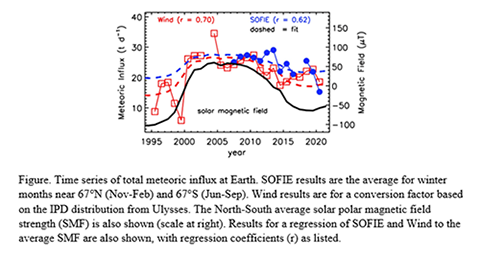|
STATUS:
10.26.2022
Instrument Status:
SOFIE
SOFIE is currently collecting sunset science observations at northern polar latitudes. Housekeeping and performance data all indicate a stable and healthy instrument. SOFIE V1.3 data are available online.
A recent study examined variations in interstellar dust (ISD) and the interplanetary dust (IPD) flux at Earth, using observations from three different satellite techniques [Hervig et al., 2022]. First are size-resolved in situ meteoroid detections by the Ulysses spacecraft, and second are in situ indirect dust observations from the Wind spacecraft. Third are measurements of meteoric smoke in the mesosphere by SOFIE. Wind and Ulysses observations are sorted into the interstellar and interplanetary components. Wind ISD show the anticipated correlation to the 22-yr. solar magnetic cycle, and are consistent with model predictions of ISD. Because Wind does not discriminate particle size, the IPD measurements were interpreted using meteoric mass distributions from Ulysses observations and from different models. Wind observations during 2007-2020 indicate a total meteoric influx at Earth of 22 metric tons per day (t d-1), in reasonable agreement with long-term averages from SOFIE (25 t d-1) and Ulysses (32 t d-1). SOFIE and Wind show similar year-to-year variations in meteoric influx (see Figure below). This suggests that IPD production, which is mostly from asteroid collisions and comet sublimation, is not constant and that these variations appear in the mesosphere. SOFIE and Wind meteoric influx furthermore shows an unexpected correlation to the 22-yr. solar cycle. This relationship could be an artifact, or may indicate that IPD responds to changes in the solar magnetic field.
Hervig, M. E., Malaspina, D., Sterken, V., Wilson, L. B., Hunziker, S., & Bailey, S. M. (2022). Decadal and annual variations in meteoric flux from Ulysses, Wind, and SOFIE observations. Journal of Geophysical Research: Space Physics, 127, e2022JA030749. (article).

|
|
|
